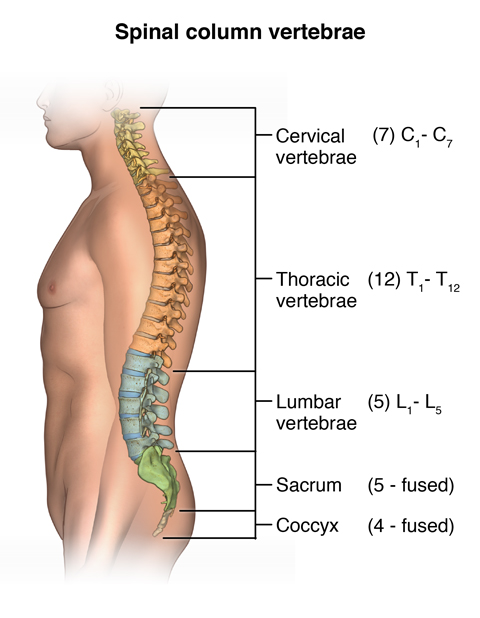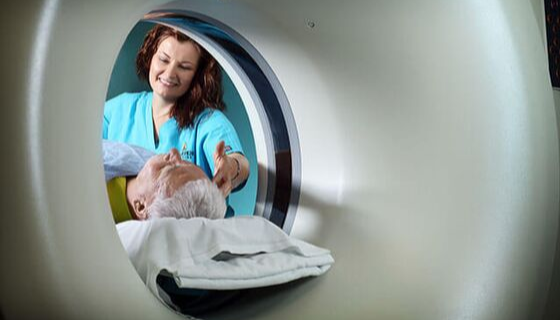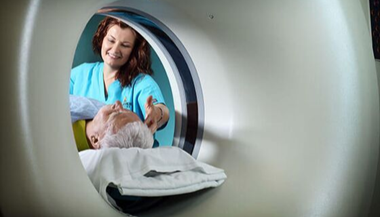X-rays of the Spine, Neck or Back
What are X-rays of the spine, neck or back?
X-rays use invisible electromagnetic energy beams to make images of internal tissues, bones, and organs on film. Standard X-rays are performed for many reasons. These include diagnosing tumors or bone injuries.
X-rays are made by using external radiation to produce images of the body, its organs, and other internal structures for diagnostic purposes. X-rays pass through body tissues onto specially-treated plates (similar to camera film) and a "negative" type picture is made (the more solid a structure is, the whiter it appears on the film). Instead of film, X-rays are now typically made by using computers and digital media.
When the body undergoes X-rays, different parts of the body allow varying amounts of the X-ray beams to pass through. Images are made in degrees of light and dark. It depends on the amount of X-rays that penetrate the tissues. The soft tissues in the body (like blood, skin, fat, and muscle) allow most of the X-ray to pass through and appear dark gray on the film. A bone or a tumor, which is denser than soft tissue, allows few of the X-rays to pass through and appears white on the X-ray. At a break in a bone, the X-ray beam passes through the broken area. It appears as a dark line in the white bone.
X-rays of the spine may be performed to evaluate any area of the spine (cervical, thoracic, lumbar, sacral, or coccygeal). Other related procedures that may be used to diagnose spine, back, or neck problems include myelography (myelogram), computed tomography (CT scan), magnetic resonance imaging (MRI), or bone scans. Please see these procedures for additional information.
Anatomy of the spine

The spinal column is made up of 33 vertebrae that are separated by spongy disks and classified into distinct areas:
-
The cervical area consists of 7 vertebrae in the neck.
-
The thoracic area consists of 12 vertebrae in the chest.
-
The lumbar area consists of 5 vertebrae in the lower back.
-
The sacrum has 5 small, fused vertebrae.
-
The 4 coccygeal vertebrae fuse to form 1 bone, called the coccyx or tailbone.
The spinal cord, a major part of the central nervous system, is located in the vertebral canal and reaches from the base of the skull to the upper part of the lower back. The spinal cord is surrounded by the bones of the spine and a sac containing cerebrospinal fluid. The spinal cord carries sense and movement signals to and from the brain and controls many reflexes.
Reasons for the procedure
X-rays of the spine, neck, or back may be performed to diagnose the cause of back or neck pain, fractures or broken bones, arthritis, spondylolisthesis (the dislocation or slipping of 1 vertebrae over the 1 below it), degeneration of the disks, tumors, abnormalities in the curvature of the spine like kyphosis or scoliosis, or congenital abnormalities.
There may be other reasons for your health care provider to recommend an X-ray of the spine, neck, or back.

Back in the Saddle After Spinal Surgery
Anne Fink made spinal surgery look like a walk in the park, but she will be the first to tell you it’s because of Johns Hopkins spine surgeon Khaled Kebaish. “Thanks to him, I’m a walking medical miracle. He gave me my life back,” she says.
Risks of the procedure
You may want to ask your health care provider about the amount of radiation used during the procedure and the risks related to your particular situation. It is a good idea to keep a record of your past history of radiation exposure, like previous scans and other types of X-rays, so that you can inform your health care provider. Risks associated with radiation exposure may be related to the cumulative number of X-ray exams and/or treatments over a long period of time.
If you are pregnant or suspect that you may be pregnant, you should notify your health care provider. Radiation exposure during pregnancy may lead to birth defects. If it is necessary for you to have a spinal X-ray, special precautions will be made to minimize the radiation exposure to the fetus.
There may be other risks depending on your specific medical condition. Be sure to discuss any concerns with your health care provider prior to the procedure.
Before the procedure
-
Your health care provider will explain the procedure to you and offer you the opportunity to ask questions that you might have about the procedure.
-
Generally, no prior preparation, like fasting or sedation, is required.
-
Notify the radiologic technologist if you are pregnant or suspect you may be pregnant.
-
Notify the radiologic technologist if you have had a recent barium X-ray procedure, as this may interfere with obtaining an optimal X-ray exposure of the lower back area.
-
Based on your medical condition, your health care provider may request other specific preparation.
During the procedure
An X-ray may be performed on an outpatient basis or as part of your stay in a hospital. Procedures may vary depending on your condition and your health care provider's practices.
Generally, an X-ray procedure of the spine, neck, or back follows this process:
-
You will be asked to remove any clothing, jewelry, hairpins, eyeglasses, hearing aids, or other metal objects that may interfere with the procedure.
-
If you are asked to remove any clothing, you will be given a gown to wear.
-
You will be positioned on an X-ray table that carefully places the part of the spine that is to be X-rayed between the X-ray machine and a cassette containing the X-ray film or digital media. Your health care provider may also request X-ray views to be taken from a standing position.
-
Body parts not being imaged may be covered with a lead apron (shield) to avoid exposure to the X-rays.
-
The radiologic technologist will ask you to hold still in a certain position for a few moments while the X-ray exposure is made.
-
If the X-ray is being performed to determine an injury, special care will be taken to prevent further injury. For example, a neck brace may be applied if a cervical spine fracture is suspected.
-
Some spinal X-ray studies may require several different positions. Unless the technologist instructs you otherwise, it is extremely important to remain completely still while the exposure is made. Any movement may distort the image and even require another study to be done to obtain a clear image of the body part in question. You may be asked to breathe in and out during a thoracic spine X-ray.
-
The X-ray beam will be focused on the area to be photographed.
-
The radiologic technologist will step behind a protective window while the image is taken.
While the X-ray procedure itself causes no pain, the manipulation of the body part being examined may cause some discomfort or pain. This is particularly true in the case of a recent injury or invasive procedure like surgery. The radiologic technologist will use all possible comfort measures and complete the procedure as quickly as possible to reduce any discomfort or pain.
After the procedure
Generally, there is no special type of care following an X-ray of the spine, back, or neck. However, your health care provider may give you additional or alternate instructions after the procedure, depending on your particular situation.





